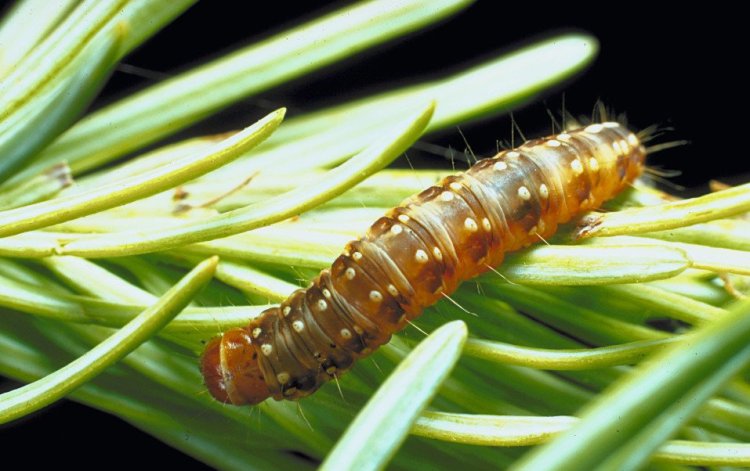Populations of spruce budworm remained low across northern Maine this year, although entomologists caution that simply means the next outbreak of the destructive forest pest is delayed, not avoided.
Landowners, forest managers and entomologists are bracing for defoliation to begin in Maine within the next several years, based on the current outbreak in Quebec. But monitoring programs in both Maine and the province of New Brunswick showed that the average number of budworm moths collected in traps actually fell from 2015 to 2016.
On average, seven moths were captured in each of the 400-plus traps set in northern, western and eastern Maine that use pheromones rather than light to attract the insects. That compares with 26 moths per trap, on average, during the 2015 season, according to statistics compiled by the Maine Forest Service.
Allison Kanoti, an entomologist with the Maine Forest Service, said in an interview Monday that both the 2015 and 2016 numbers are relatively low, so the year-to-year swing is not particularly large or surprising. Light trap surveys from previous decades show “valleys and peaks” leading up to an outbreak.
This year’s lower numbers do not alter the fact that another outbreak is coming.
“Sometime in the next several years we expect to find defoliation caused by spruce budworm in Maine,” Kanoti wrote in an update posted on the website of the Maine Forest Products Council, an industry trade group. “Even after that is found it will be several years before fir and spruce in Maine experience significant impacts to their growth. Managers and landowners with significant (spruce and fir) should use the time they have to continue to prepare for the coming epidemic.”
The spruce budworm is a native species that experiences cyclical population explosions and collapses every 30 to 60 years. During the last major outbreak in Maine during the 1970s and 1980s, budworms destroyed 20 million to 25 million cords of wood – or 21 percent of the spruce and fir stands – and caused millions of dollars in economic damage.
The extensive defoliation prompted landowners and the state to clear-cut large areas or apply huge amounts of insecticides, which in turn led to a public outcry and major changes to Maine’s forest practices laws.
Maine’s forests are more diverse today than the forests of the 1970s and 1980s, with spruce and fir now accounting for roughly 70 million standing cords compared with 130 million cords at the onset of the last budworm outbreak. And technological advances in monitoring as well as a more comprehensive logging road infrastructure give foresters and landowners additional tools.
Kanoti said she also found it reassuring that New Brunswick saw similar trends of lower moth counts this year, although the province did experience one large swarm that raised concerns on both sides of the border. The massive “flight” of budworm moths appeared to originate in a heavily infested area of Quebec and was carried by summer winds and air currents to an area of New Brunswick more than 130 miles away. The moth swarm blanketed cars, trees and the ground in some areas.
Some of those moths did turn up in traps in Maine, more than 100 miles away. But the bigger concern is the steady spread of the major infestation in Quebec.
A forecast map posted on the Maine Spruce Budworm Task Force’s website shows areas of red – indicating heavier presence of budworm larvae – creeping down toward New Brunswick and Maine.
Roughly 17.3 million acres of forests in Quebec – nearly the same size of Maine’s forested land base – has already been defoliated by the spruce budworm since 2003. Kanoti noted that defoliation has nearly doubled in an area of Quebec, Riviere-du-Loup, that is only about 30 miles from the northernmost tip of Maine.
The highest number of moths caught in one trap this year was 49, compared to numerous traps last year with an excess of 150 moths and one with 320. And the fact that most of the traps over the past three years have caught less than 50 moths is another sign the state still has “very low populations.”
A report compiled this year by a task force of state foresters, university researchers and industry representatives estimated that Maine could lose from 247,000 to 494,000 cords of wood annually if active management is not used to reduce the losses. The report estimated the economic impact at between $397 million and $794 million per year, with up to 1,200 job losses annually.
Send questions/comments to the editors.




Success. Please wait for the page to reload. If the page does not reload within 5 seconds, please refresh the page.
Enter your email and password to access comments.
Hi, to comment on stories you must . This profile is in addition to your subscription and website login.
Already have a commenting profile? .
Invalid username/password.
Please check your email to confirm and complete your registration.
Only subscribers are eligible to post comments. Please subscribe or login first for digital access. Here’s why.
Use the form below to reset your password. When you've submitted your account email, we will send an email with a reset code.